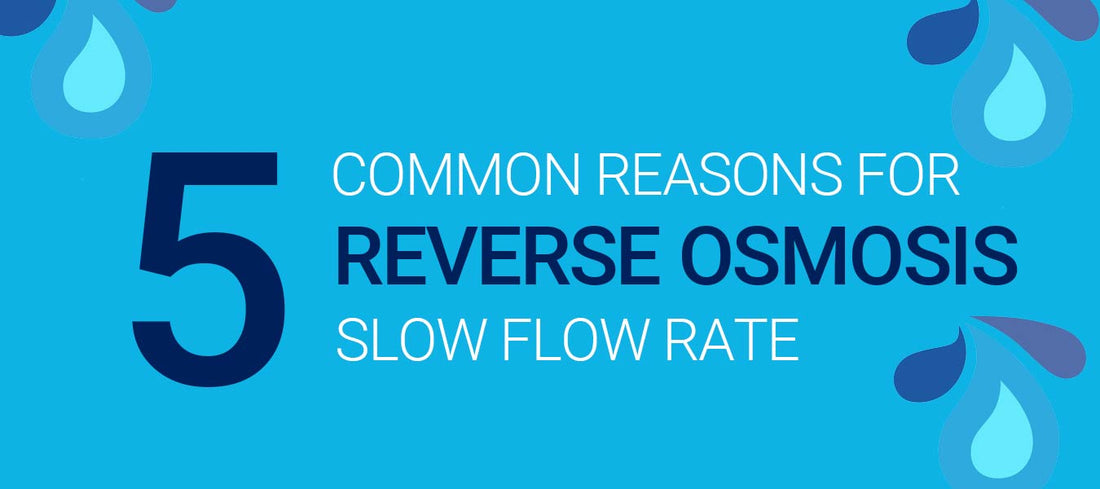Imagine going to your kitchen and having to wait for fresh filtered water from your reverse osmosis system. That’s not why you got it installed in the first place. A
reverse osmosis system relies on several parts working in harmony together and sometimes these parts can fail. This is why regular maintenance is a great idea; this can help you to catch minor issues before they develop into more significant problems that are harder and more expensive to fix. If you have noticed water from your RO system have a slower rate than normal, it could be caused by one of the following 5 reasons.
Clogged Membrane & Filters
For your RO system to work properly, the filter must be replaced at regular intervals. Over time, it can become clogged with dirt or other particles, interfering with the flow of water. Normally a reverse osmosis system takes around 2-4 hours to fill a standard-sized storage tank. If just one of the reverse osmosis filters gets clogged, it may take much longer for the storage tank to fill. This will also reduce the water pressure going to the membrane and reduce its ability to filter the water because a reverse osmosis membrane works best when it compresses under pressure. Depending on your water usage and the quality of water in your area, you should be changing the pre and post-filters every 6-12 months. RO membranes generally need to be changed every 24 months.
Buy Filters Online You might also experience slow flow rates if you are on a private water source. This is because well water often contains a high amount of water hardness and iron content which could quickly clog the filters on your reverse osmosis unit. It is highly recommended to install
specialist well treatment equipment before the water enters the reverse osmosis unit.
Kinks in Water Line
Although not very common if one of the water tubes get bent or kinked, it can slow or even stop the water flow. If your system is underneath your kitchen sink like most are, people are taking things out and putting things in all the time, and sometimes those things can press against a piece of tubing causing a blockage. Also, if the systems drain line were to get out of alignment with the drain hole on your sink’s drainpipe, it would cause back pressure on the membrane of the system causing poor quality water and slowed water production. A visual inspection of the system will often reveal the problem area and alert you to what needs to be fixed. The water supply valve should also be in the fully open position, so your inspection can confirm that at the same time.
Ruptured Tank Bladder
If your RO is only delivering a glass of water before you see the pressure drop down considerably, this may be an indication that there is a hole or rupture in the storage tank bladder. Although this is not common, over time a bladder can become weak from expanding and relaxing. This can cause small cracks in the rubber that eventually can become holes in the bladder. Unfortunately, a ruptured tank bladder cannot be repaired and you will need to replace the storage tank.
Low Air Pressure in Tank
There is a small air charge between the outside of the bladder and the inside of the tank. It's the air pressure that pushes the water out of the tank when you open the faucet. When you purchase an RO unit or a new tank, the tank is usually pre-charged with air. But tanks are like car tires: you have to put air in them as part of normal maintenance. The air valve (Schrader Valve) to check the pressure is located on the side or at the bottom of most RO tanks. The air pressure in the tank should be 7-8 psi when there is no water in it. You have to empty the tank of water to check the air pressure. Use an air pressure gauge to check the air pressure inside the RO storage tank. If the air pressure is low, add in enough air with a pump to bring it up to 7-8 psi. Only add a small amount of air at a time, if you add too much air pressure, the air bladder can rupture.
A drop of Water Pressure in Your Home
An RO filtration system needs at least 40 psi to operate and ideally it the water pressure should be 60 psi for optimal efficiency. Utility companies like Irish Water often do periodical maintenance on their water treatment equipment and pipes. During this time it is common to have a drop in your water pressure coming into the home. This will affect how your RO system works for a short time, but normal operations should resume as soon as the normal water pressure is resumed.
Get Your Reverse Osmosis Professionally Serviced
Everyone loves drinking great tasting water. Servicing your RO systems regularly keeps it in top-notch condition, thereby, delivering great quality water every time. If you’re not a do-it-yourself homeowner, don’t be afraid to ask for help with your RO system maintenance. Our service engineers are fully qualified and trained to fix any issue arising with your RO system. To book a service for your unit, simply call us at 093 60705 or visit this link.
Book a Service

